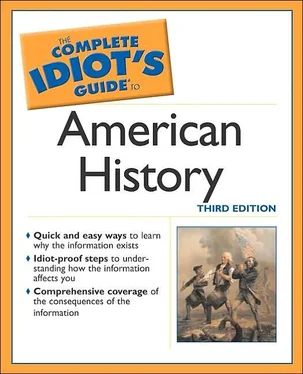Monroe tried to salve sectionalism by appointing a stellar cabinet that included the best political minds of the day, among them John Quincy Adams (Secretary of State), John C. Calhoun (Secretary of War), and William H. Crawford (Secretary of the Treasury). But these leading lights soon disputed with one another, not only over philosophical and sectional issues, but over who would succeed Monroe as president.
A Democratic-Republican, Monroe nevertheless broke with Thomas Jefferson and supported the rechartering of the Bank of the United States, which had been the brainchild of Federalist Alexander Hamilton. The bank was popular with the East Coast “establishment,” because it effectively gave them control of the nation’s purse strings. The bank was bitterly opposed by Westerners, however, who needed easy credit to expand and establish themselves.
Those Westerners also argued for a loose interpretation of the Constitution, particularly the phrase in the Preamble, “to promote the general welfare.” These words, Calhoun and Henry Clay (powerful Congressman from Kentucky) argued, mandated the federal government to build the roads the West badly needed to develop its commerce and economy. Monroe consistently vetoed road-building bills, but did support a high tariff on imports, which aided the industrialized Northeast. This tariff heightened sectional strife.
Monroe’s opposition to federally built roads for the West did not stop-and may even have spurred—development of the nation’s first great commercial link between the East Coast and the vast inland realm. Gouverneur Morris, U.S. Senator from New York, proposed in 1800 the construction of a great canal from New York City to Buffalo on Lake Erie. The project was approved by the New York legislature in 1817, and it was completed in 1825. Running 363 miles, the Erie Canal was a spectacular engineering achievement and a testament to American labor. The project was also a stunning commercial triumph, which quickly repaid the $7 million it had cost to build and soon returned an average of $3 million in annual profits—all without the assistance of the federal government.
The success of the Erie Canal, which truly inaugurated the commercial opening of the West, touched off a canal-building boom, linking the Northeast with the western system of natural waterways. By 1840, the United States boasted 3,326 miles of canals. The result was a trend toward commercial strength that helped pull the nation out of its postwar economic funk. The canals also tied the Northeast more securely to the West, thereby making deeper the growing division between the North and South, which had few east-west connections.
Among then Family of Nations
The completion and success of the Erie Canal justifiably puffed the nation’s pride, even if its economy was still shaky and the jarring demands of sectionalism increasingly strident. The United States under Monroe could at least point to growing prestige among the family of the world’s nations. Secretary of State John Quincy Adams negotiated the Rush-Bagot Agreement and the Convention of 1818 with Britain. The first document established the U.S. border with Quebec, hitherto a bone of contention, and established the precedent of a nonfortified, open border between the United States and Canada.
The second document, the Convention of 1818, addressed the issue of the disputed Oregon Territory (that is, the land west of the Rocky Mountains, north of the 42nd parallel to the 54 Degrees 42’line). The convention specified joint U.S. and British occupation of the area—a temporary solution to a hot dispute, but also a demonstration that England now took American sovereignty seriously.
On February 12, 1819, Adams concluded a treaty with Luis de Onis, Spain’s minister to Washington, that secured both western and eastern Florida for the United States. With the acquisition of Florida, a prime objective of the War of 1812 was realized—albeit belatedly. A thornier problem was the establishment of the border between the United States and Mexico, at the time a colonial possession of Spain. Adams wanted a border that would pull Texas into American territory. However, to get Florida, he ultimately sacrificed Texas and agreed on a boundary at the Sabine River, the western boundary of the present-day state of Louisiana. The United States renounced all claims to Texas. That renunciation was destined to endure during the handful of years before the revolutions by which Mexico won its independence from Spain. After the Texan War for Independence in 1836, U.S. rights to the territory would become a cause of war.
Yet one more treaty was concluded, this one with the czar of Russia, who had asserted a claim to the California coast as far south as San Francisco Bay. Adams managed to talk Czar Alexander I into a position north of the 54 Degrees 42’ line, so that Russia would no longer be a contender for the Oregon Territory. The czar did retain his claim to Alaska, which at the time, nobody in the United States wanted anyway.
Although these foreign agreements were of great importance to establishing American sovereignty, the cornerstone of Monroe’s foreign policy came in 1823 and has been stamped with the president’s name. The origin of the Monroe Doctrine is found in the turbulent years of the Napoleonic Wars. These wars touched South America, sparking widespread revolution. After peace was re-established in Europe in 1815, Spain began making noises about reclaiming its colonies. President Monroe responded in his 1823 message to Congress with the four principles now known as the Monroe Doctrine:
1. The Americas were no longer available for colonization by any power.
2. The political system of the Americas was essentially different from that of Europe.
3. The United States would consider any interference by European powers in the Americas a direct threat to U.S. security.
4. The United States would not interfere with existing colonies or with the internal affairs of European nations, nor would the U.S. participate in European wars.
The so-called Era of Good Feelings was filled with plenty of distinctly bad feelings, a mixture of present financial hardships and an anxiety-filled foreboding of political and civil calamity just over the horizon.
Monroe and Calhoun were driven by a vision of what came to be called the “American System,” a way of harnessing the full power of the federal government to nurture struggling American industry through a protective tariff to ward off competition from imports; the creation of the Bank of the United States to provide a reliable source of credit to industry; and federal financing of road, canal, and harbor construction. Unfortunately, Monroe and Calhoun were never able to agree on all three of these components. While both supported the bank, Monroe repeatedly vetoed bills to fund “internal improvements”—roads and the like—while he endorsed heavy tariffs. Without adequate transport, Calhoun noted with bitterness, the West could not compete commercially with the East. He also said that the tariff, instead of protecting all American industry, fostered eastern development while operating to keep the isolated West financially strapped. A three-legged stool can stand; a two-legged one cannot. The American economy tottered.
Economic conditions in the wake of the War of 1812 read like a recipe for disaster:
Start with a grinding war debt.
Add high tariffs to create commodity inflation.
Stir in wild speculation on western lands opened by the war.
Overextend manufacturing investments.
Читать дальше












